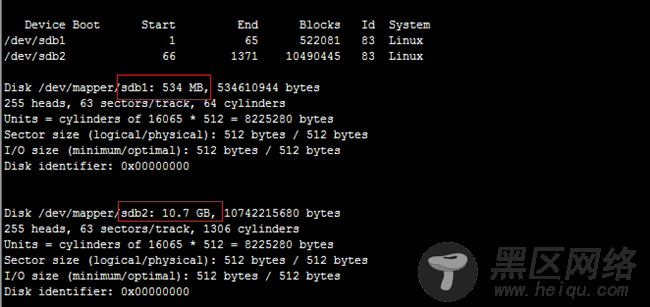Linux操作系统至1991.10.5号诞生以来,就源其开源性和自由性得到了很多技术大牛的青睐,每个Linux爱好者都为其贡献了自己的一份力,不管是在Linux内核还是开源软件等方面,都为我们后来人提供了一个良好的学习和研究环境。做为一个Linuxer,感谢各位前辈们为我们提供一个自由的空间,让我们也能够在学习的同时去研究Linux。
本文主要通过裁剪现有Linux系统,打造一个属于自己的Linux小系统,让其能够装载网卡驱动,并配置IP地址,实现网络功能。
二、原理
启动流程介绍
制作linux小系统之前,我们有必要再了解一下linux的启动流程:
1、首先linux要通过POST自检,检查硬件设备有没有故障
2、如果有多块启动盘的话,需要在BIOS中选择启动磁盘
3、启动MBR中的bootloader引导程序
4、加载内核文件
5、执行所有进程的父进程、老祖宗init
6、打印欢迎界面
在linux的启动流程中,加载内核文件时还需要借助别外两个文件:
1)initrd,是CentOS5上用内存模拟的磁盘设备
2)initramfs,是CentOS6上用内存模拟的文件系统
在启程的流程中,init主要是用来做哪些操作的呢?
init通过调用/etc/inittab这个配置文件,然后再去执行/etc/rc.d/rc.sysinit的系统初始化脚本
启发
到linux打印欢迎界面后,就说明系统已经启动成功,如果我们要制作一个linux小系统,我们只需要把它在开机流程中用到的各文件都装载到一起,就可以点亮属于我们自己的系统了,而linux是一个模块化的操作系统,好多功能组件都是通过模块化的工具来实现的,而且支持动态装载和卸载,我们要是想实现某种功能,只需加载相应的模块即可,就可以实现我们的linux操作系统大瘦身了。
三、操作步骤
1、目标磁盘分区
在宿主机上挂一块新磁盘,命名为soft-linux,此块磁盘是宿主机上的第二块磁盘,所以这里是/dev/sdb,而到时候挂载到目标主机的时候,因为那里只有这一块磁盘,所以在目标主机上的名称应该是/dev/sda,这个不能搞混了。首先,我们要在目标磁盘上分两个区,并进行格式化。第一个分区500M,用来装引导程序;第二个分区10G,用来装根文件系统。然后再进行挂载操作,将/dev/sdb1挂载到/mnt/boot下,将/dev/sdb2挂载到/mnt/sysroot下。

[root@changsheng ~]# mount /dev/sdb1 /mnt/boot
mount: mount point /mnt/boot does not exist
[root@changsheng ~]# mkdir -p /mnt/boot /mnt/sysroot
[root@changsheng ~]# mount /dev/sdb1 /mnt/boot
[root@changsheng ~]# mount /dev/sdb2 /mnt/sysroot/
[root@changsheng ~]#
2、安装grub至目标磁盘
一个系统能启动,就需要引导,所以我们首先要安装一个grub引导程序到我们的新磁盘上,安装grub引导程序主要有两个命令,一个是grub-install,另一个是setup,这里最好使用grub-install来安装。因为:
①grub-install会安装grub引导第二阶段的文件
②setup不会安装第二阶段的引导程序,是安装引导信息到MBR
第二个需要注意的地方就是--root-directory=后面接的路径应该是boot目录所在的地方,而不是/mnt/boot,因为boot目录在mnt下;目标磁盘是/dev/sdb
[root@changsheng ~]# grub-install --root-directory=/mnt /dev/sdb
Probing devices to guess BIOS drives. This may take a long time.
Installation finished. No error reported.
This is the contents of the device map /mnt/boot/grub/device.map.
Check if this is correct or not. If any of the lines is incorrect,
fix it and re-run the script `grub-install'.
(fd0) /dev/fd0
(hd0) /dev/sda
(hd1) /dev/sdb
[root@changsheng ~]# cd /mnt/boot/
[root@changsheng boot]# ls
grub lost+found
[root@changsheng boot]# cd grub/
[root@changsheng grub]# ls
device.map e2fs_stage1_5 fat_stage1_5 ffs_stage1_5 iso9660_stage1_5 jfs_stage1_5 minix_stage1_5 reiserfs_stage1_5 stage1 stage2 ufs2_stage1_5 vstafs_stage1_5 xfs_stage1_5
[root@changsheng grub]#
安装完grub后,进入grub目录,会发现没有grub.conf配置文件,这样就导致我们的引导程序是不健全的,所以我们需要手动写一个配置文件在里边,不过这得需要知道内核的版本,等移植完内核版本,再回过头来补充此步。
3、复制内核文件和initrd文件
init是系统中用来产生其它所有进程的程序。它以守护进程的方式存在,其进程号为1,init是所有进程的父进程,老祖宗,所以不移植是不行的。它通过调用/etc/inittab这个配置文件,然后再去执行/etc/rc.d/rc.sysinit的系统初始化脚本。
将内核文件和initrd文件复制到/dev/sdb下的boot目录中。
[root@changsheng grub]# cp /boot/vmlinuz-2.6.32-358.el6.x86_64 /mnt/boot/vmlinuz-soft
[root@changsheng grub]# cp /boot/initramfs-2.6.32-358.el6.x86_64.img /mnt/boot/initramfs-soft.img
[root@changsheng grub]#
4、创建目标主机根文件系统
①使用命令行展开创建文件系统
[root@changsheng sysroot]# mkdir -pv /mnt/sysroot/{etc/rc.d,usr,var,proc,sys,dev,lib,lib64,bin,sbin,boot,srv,mnt,media,home,root}
mkdir: created directory `/mnt/sysroot/etc'
mkdir: created directory `/mnt/sysroot/etc/rc.d'
mkdir: created directory `/mnt/sysroot/usr'
mkdir: created directory `/mnt/sysroot/var'
mkdir: created directory `/mnt/sysroot/proc'
mkdir: created directory `/mnt/sysroot/sys'
mkdir: created directory `/mnt/sysroot/dev'
mkdir: created directory `/mnt/sysroot/lib'
mkdir: created directory `/mnt/sysroot/lib64'
mkdir: created directory `/mnt/sysroot/bin'
mkdir: created directory `/mnt/sysroot/sbin'
mkdir: created directory `/mnt/sysroot/boot'
mkdir: created directory `/mnt/sysroot/srv'
mkdir: created directory `/mnt/sysroot/mnt'
mkdir: created directory `/mnt/sysroot/media'
mkdir: created directory `/mnt/sysroot/home'
mkdir: created directory `/mnt/sysroot/root'
[root@changsheng sysroot]# ls
bin boot dev etc home lib lib64 lost+found media mnt proc root sbin srv sys usr var
[root@changsheng sysroot]#
②移植bash命令和其库文件到根文件系统
[root@changsheng mnt]# sh ~/scripts/cporder.sh
Enter a command: bash
Enter a command: shutdown
Enter a command: reboot
Enter a command: vim
Enter a command: touch
Enter a command: mkdir
Enter a command: rm
Enter a command: ls
Enter a command: cat
Enter a command: less
Enter a command: ifconfig
Enter a command: ip
Enter a command: route
Enter a command: quit
quit
[root@changsheng mnt]# sync
[root@changsheng mnt]# sync
[root@changsheng mnt]# ls
boot sysroot
[root@changsheng mnt]# cd sysroot/
[root@changsheng sysroot]# ls
bin lib64 sbin usr
[root@changsheng sysroot]# cd bin/
[root@changsheng bin]# ls
bash cat ls mkdir rm touch
[root@changsheng bin]# ln -sv bash sh
`sh' -> `bash'
[root@changsheng bin]# sync
[root@changsheng bin]#
附:命令移植脚本
#!/bin/bash
#
target=/mnt/sysroot
clearCmd() {
if which $cmd &> /dev/null; then
cmdPath=`which --skip-alias $cmd`
else
echo "No such command"
return 5
fi
}
cmdCopy() {
cmdDir=`dirname $1`
[ -d ${target}${cmdDir} ] || mkdir -p ${target}${cmdDir}
[ -f ${target}${1} ] || cp $1 ${target}${cmdDir}
}
libCopy() {
for lib in `ldd $1 | grep -o "/[^[:space:]]\{1,\}"`; do
libDir=`dirname $lib`
[ -d ${target}${libDir} ] || mkdir -p ${target}${libDir}
[ -f ${target}${lib} ]
|| cp $lib ${target}${libDir}
done
}
while true; do
read -p "Enter a command: " cmd
if [ "$cmd" == 'quit' ] ;then
echo "quit"
exit 0
fi
clearCmd $cmd
[ $? -eq 5 ] && continue
cmdCopy $cmdPath
libCopy $cmdPath
done
5、为grub提供配置文件
上面移植了内核和initrd文件,我们就可以根据内核版本和initrd版本来编写grub.conf配置文件了
[root@changsheng grub]# vim grub.conf
default=0
timeout=5
title changsheng soft-linux
root (hd0,0)
kernel /vmlinuz-soft ro root=/dev/sda2 quiet selinux=0 init=/bin/bash
initrd /initramfs-soft.img
~

